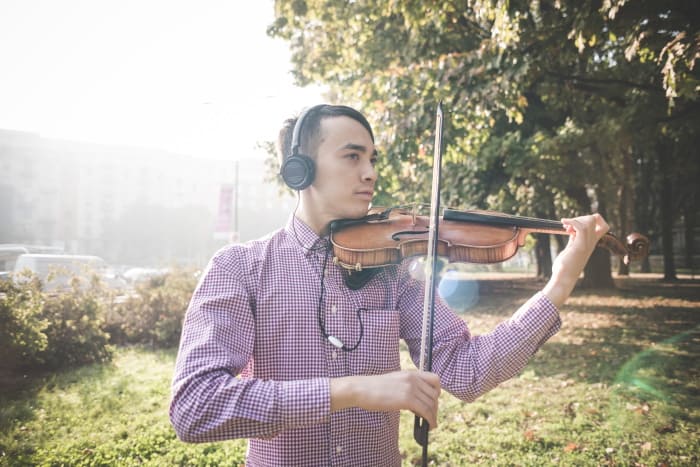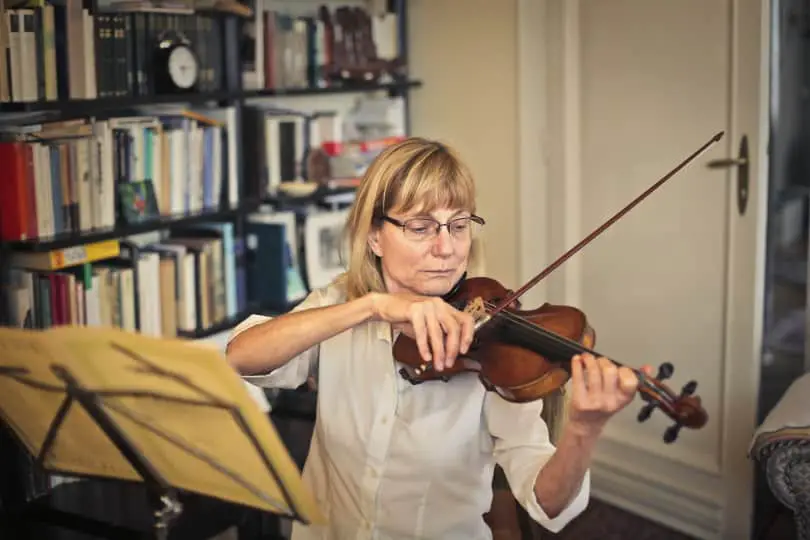Violin players must always keep the neighbors them in mind when practicing at home. It makes some of us nervous about being too loud, leading to cut practice times and trying to play as quiet as possible, which prevents us from hearing the full range of sound.
Is a violin too loud for an apartment?
Violins produce upward of 90dB when playing, loud enough to disturb apartment neighbors, even to use earplugs when practicing. However, it’s possible to play in your apartment by carefully choosing your practice hours, soundproofing your playing room, and using a practice mute as much as possible.
There’s more you can do than just asking the landlord’s permission to play, however. One strategy is to examine your building’s rules and negotiate some practice time with your neighbors – something they’ll likely appreciate.
Table of Contents
Is a violin too loud for an apartment?
Everyone living in an apartment complex should expect a “reasonable” amount of noise, but keep in mind that everyone has a different idea of what that reasonable amount of noise truly is.
As a rule of thumb, playing a musical instrument around 6 pm is usually acceptable, as mid-afternoon weekdays tend to have people out of the home. Some musicians avoid practicing between 1 pm and 3 pm to allow for quiet lunch hours.
Practicing before 10 am or after 9 pm can be possible provided you use a practice mute – see below.
Check in with your neighbors to know when they’re out of the house, so you can create a time window when you can practice. Simply asking them can make them more tolerant towards the noise as they’ll appreciate your consideration.
Families with small children tend to be more tolerant about letting people practice music since their children tend to make noise. However, keep in mind that children have bedtimes so try to adjust your practice window accordingly.
Check your lease contract for noise rules in your apartment complex. Some contracts may set a time limit for music practice, e.g. no 4 hours max per day.
If you’re looking for a new place, try to shoot for a ground-level apartment. Sound mostly flows downward rather than upwards, so being at ground level eliminates concerns about disturbing your downstairs neighbors.
Can you practice violin quietly?

Using a practice mute for your violin is a good way to make practicing in an apartment acceptable. A mute is a device that fits on your violin’s bridge and reduces noise drastically.
Violin mutes drastically reduce noise levels. While normal sound levels for a violin are at 90 dB and up, mutes bring it down to 60-75 dB – about the same sound as a normal conversation. Most apartment walls are thick enough not to let the sound through.
Mutes are a cheap, reliable, and effective way to make the instrument as quiet as possible, yet not so much that you won’t hear yourself play. There are three types of violin mutes:
Rubber violin mutes
Cheap, easy-to-use, and reliable rubber mutes somewhat bring down noise levels. They won’t make your violin as quiet as an unamplified electric violin, but they can still make the neighbors happy. Rubber mutes also keep the strings safe from damage.
Metal violin mutes
Metal mutes are very effective at really muting your volume but require more care to use. The hard material can cause severe damage to your strings if misused – mounting it the wrong way or accidental striking it can snap your strings.
Brass mutes are the ultimate noise dampeners for violins but come with the significant drawback of messing up your intonation. Your muscle memory may end up making the wrong notes when you stop using a brass mute.
Synthetic Mutes

These are becoming increasingly popular. They are great because their segments force minimal pressure on the strings while reducing string vibration. Without limiting bow movement, synthetic mutes reduce the overtone and attenuate the sound significantly.
Synthetic mutes are considered the best quality mutes but are pricier. They are flexible so that their soft body fits any violin setup. Brands like Wiessmeyer & Son, known for making rubber mutes, are now starting to produce mutes with synthetic materials.
If you don’t have access to a mute, clipping a wooden clothespin onto the bridge is known to work quite well as a mute!
Playing with a mute does have its disadvantages. We already mentioned the intonation issues. Also, the vibrations from your violin can rattle and eventually knock off the mute. And, metal mutes come with the risk of damaging your strings.
Soundproofing an apartment for violin practice
Another way to practice the violin in an apartment without making the neighbors angry is to soundproof your practice room.
Soundproofing is typically a challenging job that requires a professional. A fair bit of renovation is involved which may you landlord may not allow in your apartment, e.g. installing double doors or upgrading the walls and floors with foam or cork.
Of course, DIY options such as soundproofing foam can be installed in a particular room. You can put thick soundproofing curtains and rugs on your windows and floors to help absorb the sound. Large bookcases or drawers can also reduce the noise that goes through the walls.
Using an electric violin for practicing in an apartment
Using an electric violin is another option for quiet practice in an apartment. You can pair a solid-body electric violin with a small amp and a set of headphones.
As the sound is beamed directly to your ears, the lack of external amplification makes your playing virtually soundless. Even without an amp, though, some electric violins may sound loud as a heavily muted violin.
A significant drawback is that electric violins will feel like playing a completely different instrument compared to an acoustic violin. Amps eliminate many of the subtle things violins try to perfect, and switching between the two types of violins can be a bit odd, especially if you clock in more practice hours in either kind.
One of the best electric violins for practicing at home is the Yamaha YSV104. It plays and feels quite close to an acoustic violin, makes virtually no sound when unamplified, and works great with the headphones.
Final word
Practicing the violin in an apartment isn’t all that difficult but does require some preparation. Consideration for others, especially in apartments close together, is the first thing you should have.
Investing in gear, trying to soundproof what you can, sticking to a time window, and letting your neighbors know is the best way to have a hassle-free, in-house practice session.


Comments are closed.